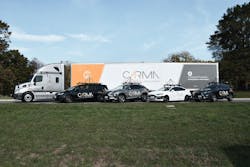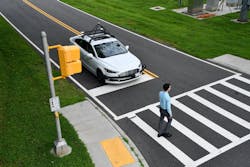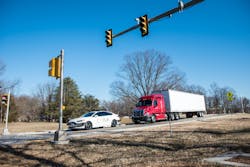The digital roadway
The average driver spends 54 hours and 21 gallons of fuel stalled in traffic each year, according to the Texas A&M Transportation Institute. That amounts to $1,080 in wasted time and fuel.
The challenges facing the U.S. transportation system extend beyond mobility. As demand on our nation’s roadways increases, so too do issues related to safety, efficiency, and sustainability. Transportation planners face the realization that adding new infrastructure capacity is costly and time consuming. As a result, a growing number of transportation researchers are embracing creative new methods of improving safety, efficiency, and sustainability.
A groundbreaking initiative by the Federal Highway Administration (FHWA) is addressing such needs, in hopes of propelling the transportation system into the digital age.
The Cooperative Driving Automation Research Program
The Cooperative Driving Automation (CDA) Research Program is building digital capabilities into existing infrastructure and developing platforms for the collaborative research and development (R&D) of CDA, with the goal of establishing a fully connected transportation system.
Defined by the Society of Automotive Engineers (SAE) J3216 Standard, CDA is automation that uses machine-to-machine (M2M) communication to enable cooperation among two or more entities with communications technology. CDA is intended to facilitate the safer, more efficient movement of road users, including enhancing performance of the dynamic driving task (DDT) for a vehicle with driving automation feature(s) engaged.
The introduction of CDA technology to the nation’s roads presents a long-term, cost-effective solution that enables use of existing infrastructure to advance transportation systems management and operations strategies (TSMO) to move traffic more efficiently. The CDA Research Program at FHWA will demonstrate the role of digital infrastructure to support and enable CDA technologies. In addition, the program is trying to investigate how to achieve full integration across the entire transportation system, including the seamless cooperation of automated vehicles (AVs) and other users on the roadway.
The CARMA Program
As part of the CDA Research Program, FHWA’s CARMA Program is a technology-enabling initiative focused on improving the transportation system by leveraging emerging automated driving technology and vehicle-to-everything (V2X) technology to enhance safety, operational efficiency, and sustainability in moving people and goods.
FHWA’s CARMA Program is advancing the R&D of CDA to accelerate its market readiness and deployment. Through collaboration and open source software (OSS) development, CARMA enables researchers and engineers to research, develop, test, and evaluate CDA features on infrastructure and properly equipped vehicles—setting the foundation for interoperability across transportation infrastructure as well as vehicle make and model.
CDA will improve the operations of the transportation system by leveraging transformative capabilities from smart infrastructure and automated vehicles. The CARMA Program is founded on collaboration and seeks to work with industry in new and innovative ways, such as through OSS development.
As a tech-enabling support program focused on digital infrastructure innovation, CARMA is paving the way for the safe, efficient, and sustainable introduction of CDA technology on our nation’s roads.
Testing and use cases
FHWA’s CARMA Program includes a suite of open source products that support informed and dynamic cooperation among vehicles. The CARMA Platform product is a downloadable, vehicle-based platform that bestows the research functionality of a cooperative automated driving system (C-ADS), defined by the SAE J3216 Standard.
The current version of CARMA Platform launched on GitHub in 2019. This has ADS functionality from Autoware, such as localization, motion planning, obstacle detection and avoidance, steering and speed control, and environment sensing. The CARMA team added V2X communication and focused on developing the cooperative features to enable the first research grade SAE C-ADS Level 3 Class A-D platform.
The FHWA is operating CARMA Platform on three different types of passenger vehicles with three different brands of controller modules. With a focus on the transportation system, the CARMA Program developed the complete ecosystem by adding CARMA Messenger, CARMA Cloud, and CARMA Streets to support the research. With these tools, the FHWA is focused on researching the role of digital infrastructure and how CDA can best support connected and automated vehicles in the transportation system.
Through a multipronged approach, the CDA Research Program considers integration among all participants in a connected transportation system. In addition to passenger vehicles, CARMA is advancing CDA applications for freight/commercial motor vehicles (e.g., platooning), transit, pedestrians, and bicyclists.
The FHWA is developing several TSMO use case scenarios for CDA to advance cooperation between infrastructure and automated driving technology. TSMO use case scenarios include basic travel, traffic incident management, road weather management, and work zone management. The use cases aim to anticipate the scope of impacts introduced by CDA deployment, including how it will affect existing TSMO strategies throughout the transportation system.
Through collaboration with leading innovators, policymakers, and subject-matter experts at the forefront of transportation research, the CDA Research Program promotes testing in a community of CARMA users, such as the Texas A&M grant team, AVS grant team, and Drive Ohio. Testing aims to educate stakeholders on CARMA, enable users to test their CARMA capabilities, and build awareness for the benefits of CDA application to transportation. With the help of numerous stakeholders, testing is being conducted at sites across the country. New partnerships are continuously being formed, with the goal of accelerating CDA R&D and encouraging industry adoption.
Looking ahead
Designing a well-integrated system is a challenge, and the CDA Research Program is employing innovation to address evolving transportation system needs.
The endless availability of information and data in today’s world has unlocked opportunities to design a more efficient and user-centric transportation system. With the technology being developed by FHWA and its partners, the outlook for a fully connected transportation system is quickly becoming the expectation.
Supported by the CARMA Program, FHWA’s CDA Research Program aims to advance the market readiness, safe deployment, and adoption of CDA and infrastructure connectivity to power leaps in transportation system operations, safety, and efficiency.
FHWA’s CDA Research Program is facilitating critical research that will alter the transportation landscape in the coming years. More information about the program, including opportunities to collaborate and contribute to this research, can be found at FHWA’s website: https://highways.dot.gov/research/operations/CARMA.


